height OPEL MERIVA 2017 Owners Manual
[x] Cancel search | Manufacturer: OPEL, Model Year: 2017, Model line: MERIVA, Model: OPEL MERIVA 2017Pages: 251, PDF Size: 8.14 MB
Page 9 of 251
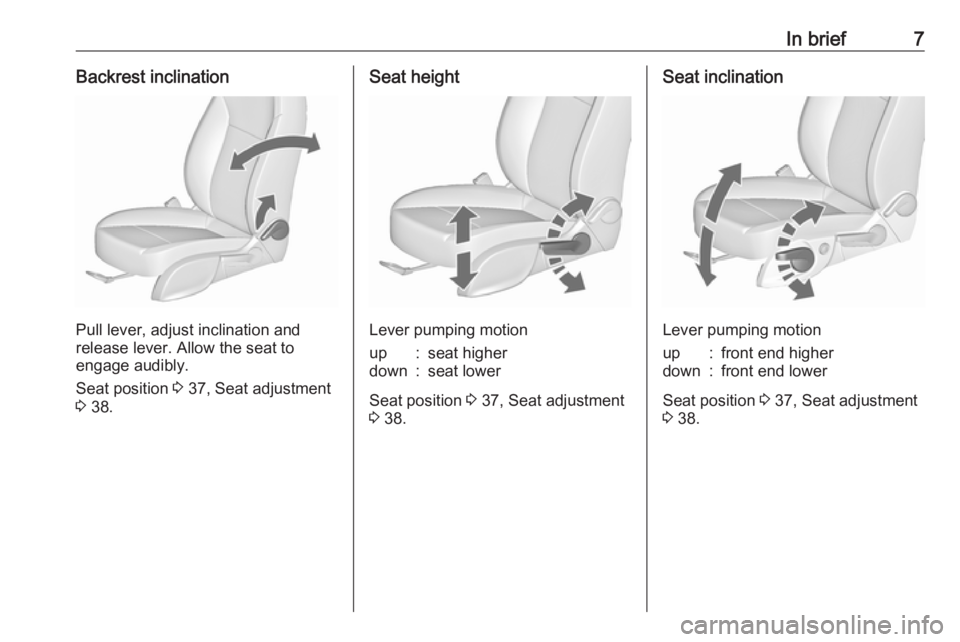
In brief7Backrest inclination
Pull lever, adjust inclination and
release lever. Allow the seat to
engage audibly.
Seat position 3 37, Seat adjustment
3 38.
Seat height
Lever pumping motion
up:seat higherdown:seat lower
Seat position 3 37, Seat adjustment
3 38.
Seat inclination
Lever pumping motion
up:front end higherdown:front end lower
Seat position 3 37, Seat adjustment
3 38.
Page 10 of 251
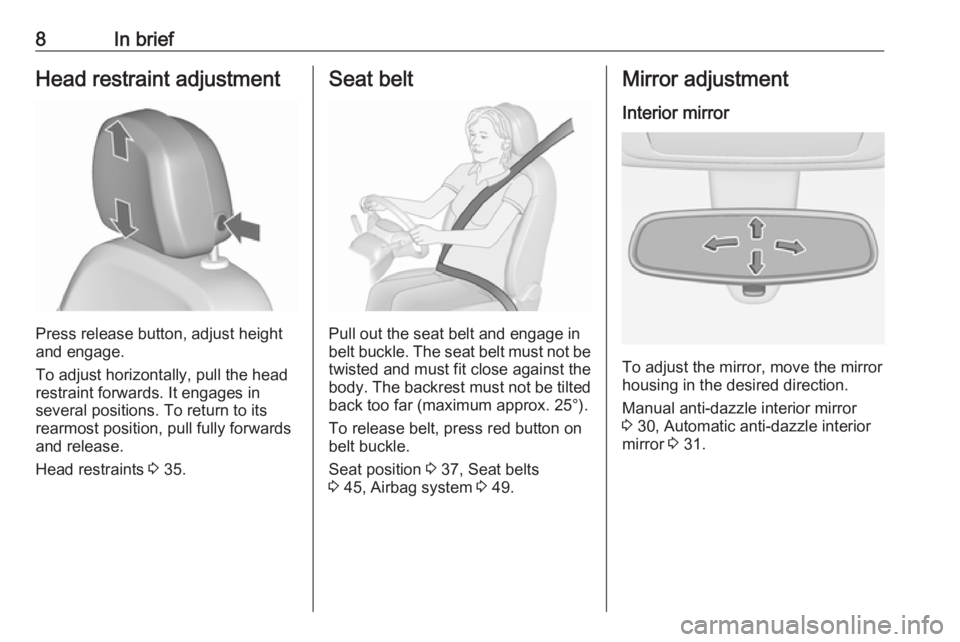
8In briefHead restraint adjustment
Press release button, adjust height
and engage.
To adjust horizontally, pull the head
restraint forwards. It engages in
several positions. To return to its rearmost position, pull fully forwards
and release.
Head restraints 3 35.
Seat belt
Pull out the seat belt and engage in
belt buckle. The seat belt must not be twisted and must fit close against the
body. The backrest must not be tilted
back too far (maximum approx. 25°).
To release belt, press red button on
belt buckle.
Seat position 3 37, Seat belts
3 45, Airbag system 3 49.
Mirror adjustment
Interior mirror
To adjust the mirror, move the mirror
housing in the desired direction.
Manual anti-dazzle interior mirror
3 30, Automatic anti-dazzle interior
mirror 3 31.
Page 37 of 251
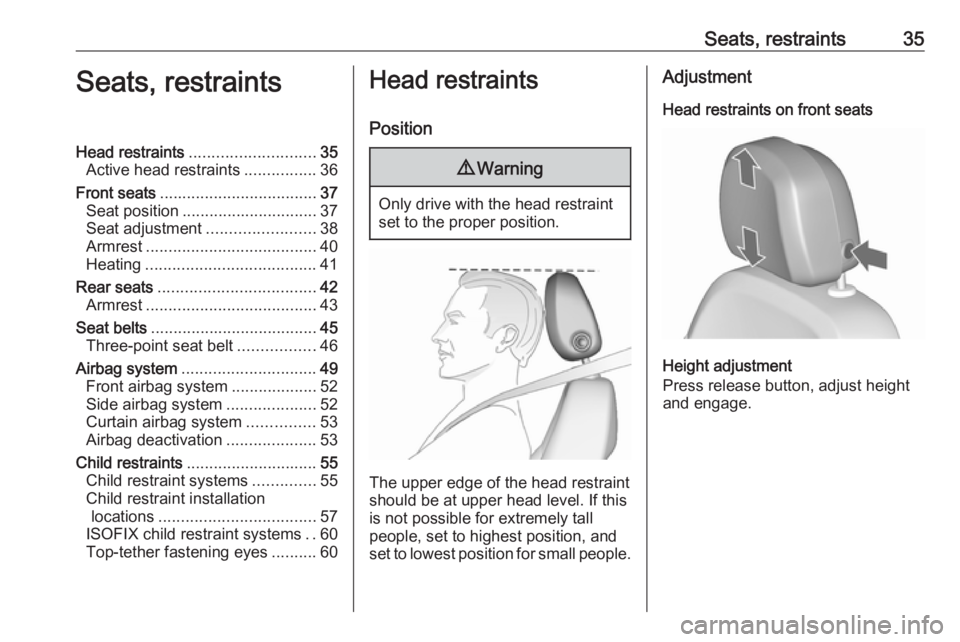
Seats, restraints35Seats, restraintsHead restraints............................ 35
Active head restraints ................36
Front seats ................................... 37
Seat position .............................. 37
Seat adjustment ........................38
Armrest ...................................... 40
Heating ...................................... 41
Rear seats ................................... 42
Armrest ...................................... 43
Seat belts ..................................... 45
Three-point seat belt .................46
Airbag system .............................. 49
Front airbag system ...................52
Side airbag system ....................52
Curtain airbag system ...............53
Airbag deactivation ....................53
Child restraints ............................. 55
Child restraint systems ..............55
Child restraint installation locations ................................... 57
ISOFIX child restraint systems ..60
Top-tether fastening eyes ..........60Head restraints
Position9 Warning
Only drive with the head restraint
set to the proper position.
The upper edge of the head restraint
should be at upper head level. If this
is not possible for extremely tall
people, set to highest position, and
set to lowest position for small people.
Adjustment
Head restraints on front seats
Height adjustment
Press release button, adjust height
and engage.
Page 38 of 251

36Seats, restraintsHorizontal adjustment
To adjust horizontally, pull the head
restraint forwards. It engages in
several positions.
To return to its rearmost position, pull fully forwards and release.
Head restraints on rear seats
Height adjustment
Pull the head restraint upwards or
press catch to release and push the head restraint downwards.
Active head restraints
In the event of a rear-end impact, the
front parts of the active head
restraints are moved slightly
forwards. Thus the head is supported so that the risk of whiplash injury is
reduced.
Note
Approved accessories may only be
attached if the seat is not in use.
Page 39 of 251
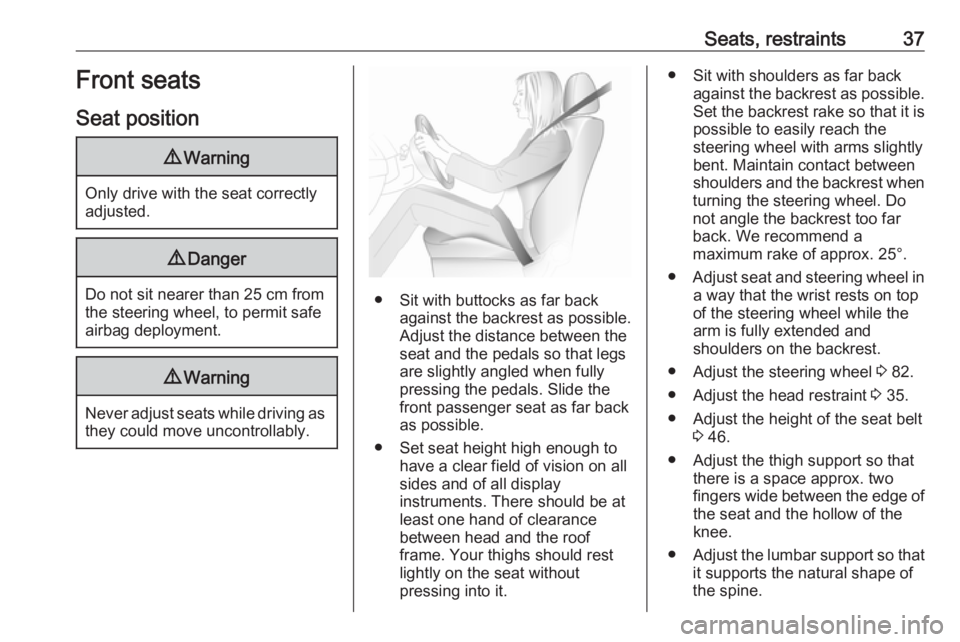
Seats, restraints37Front seats
Seat position9 Warning
Only drive with the seat correctly
adjusted.
9 Danger
Do not sit nearer than 25 cm from
the steering wheel, to permit safe
airbag deployment.
9 Warning
Never adjust seats while driving as
they could move uncontrollably.
● Sit with buttocks as far back against the backrest as possible.
Adjust the distance between the
seat and the pedals so that legs
are slightly angled when fully
pressing the pedals. Slide the
front passenger seat as far back
as possible.
● Set seat height high enough to have a clear field of vision on all
sides and of all display
instruments. There should be at
least one hand of clearance
between head and the roof
frame. Your thighs should rest
lightly on the seat without
pressing into it.
● Sit with shoulders as far back against the backrest as possible.
Set the backrest rake so that it is possible to easily reach the
steering wheel with arms slightly
bent. Maintain contact between
shoulders and the backrest when
turning the steering wheel. Do
not angle the backrest too far
back. We recommend a
maximum rake of approx. 25°.
● Adjust seat and steering wheel in
a way that the wrist rests on top
of the steering wheel while the
arm is fully extended and
shoulders on the backrest.
● Adjust the steering wheel 3 82.
● Adjust the head restraint 3 35.
● Adjust the height of the seat belt 3 46.
● Adjust the thigh support so that there is a space approx. two
fingers wide between the edge of the seat and the hollow of the
knee.
● Adjust the lumbar support so that
it supports the natural shape of the spine.
Page 40 of 251
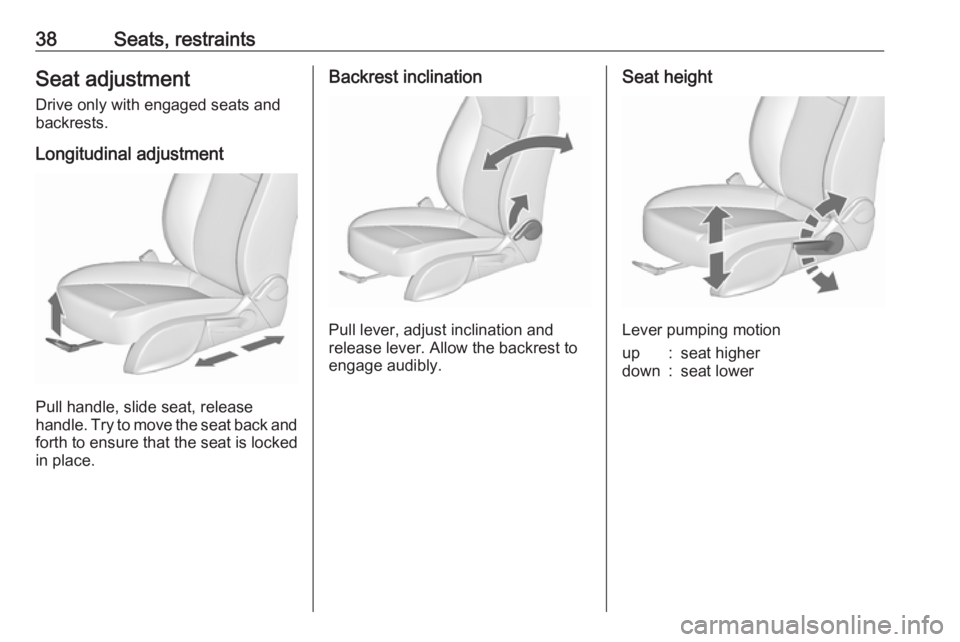
38Seats, restraintsSeat adjustment
Drive only with engaged seats and
backrests.
Longitudinal adjustment
Pull handle, slide seat, release
handle. Try to move the seat back and forth to ensure that the seat is locked
in place.
Backrest inclination
Pull lever, adjust inclination and
release lever. Allow the backrest to
engage audibly.
Seat height
Lever pumping motion
up:seat higherdown:seat lower
Page 49 of 251
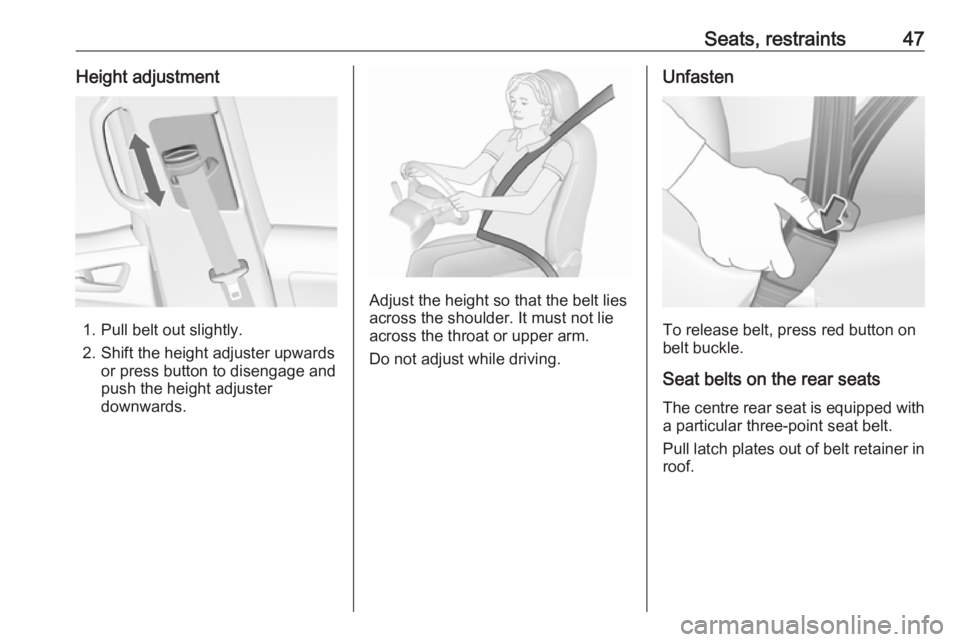
Seats, restraints47Height adjustment
1. Pull belt out slightly.
2. Shift the height adjuster upwards or press button to disengage and
push the height adjuster
downwards.
Adjust the height so that the belt lies
across the shoulder. It must not lie
across the throat or upper arm.
Do not adjust while driving.
Unfasten
To release belt, press red button on
belt buckle.
Seat belts on the rear seats
The centre rear seat is equipped with a particular three-point seat belt.
Pull latch plates out of belt retainer in
roof.
Page 59 of 251
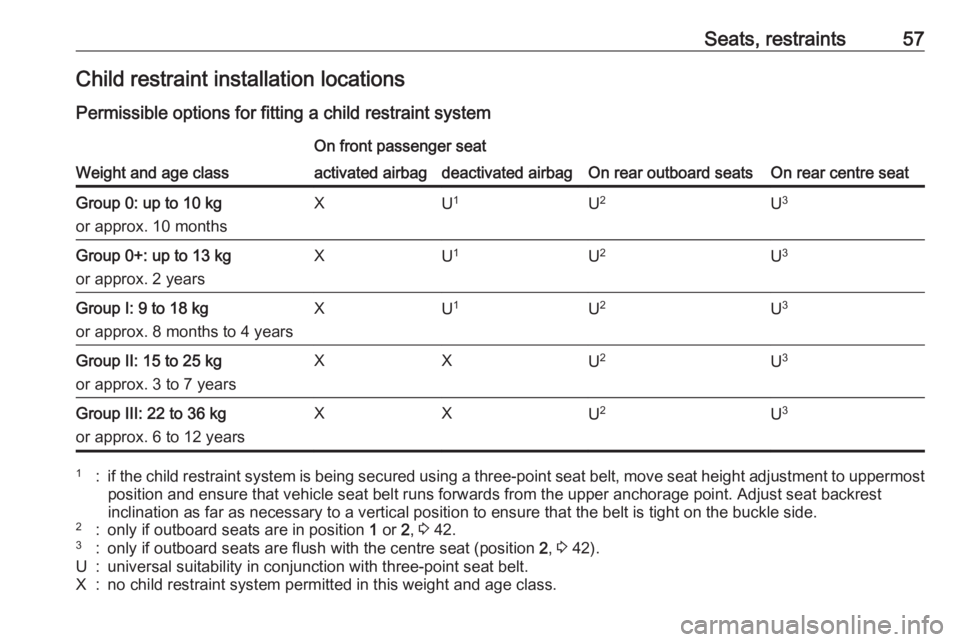
Seats, restraints57Child restraint installation locations
Permissible options for fitting a child restraint system
Weight and age class
On front passenger seat
On rear outboard seatsOn rear centre seat
activated airbagdeactivated airbagGroup 0: up to 10 kg
or approx. 10 monthsXU 1U 2U3Group 0+: up to 13 kg
or approx. 2 yearsXU 1U 2U3Group I: 9 to 18 kg
or approx. 8 months to 4 yearsXU 1U2U3Group II: 15 to 25 kg
or approx. 3 to 7 yearsXXU 2U3Group III: 22 to 36 kg
or approx. 6 to 12 yearsXXU 2U31:if the child restraint system is being secured using a three-point seat belt, move seat height adjustment to uppermost
position and ensure that vehicle seat belt runs forwards from the upper anchorage point. Adjust seat backrest
inclination as far as necessary to a vertical position to ensure that the belt is tight on the buckle side.2:only if outboard seats are in position 1 or 2, 3 42.3:only if outboard seats are flush with the centre seat (position 2, 3 42).U:universal suitability in conjunction with three-point seat belt.X:no child restraint system permitted in this weight and age class.
Page 176 of 251

174Vehicle care
Press the safety catch and open the
bonnet.
Secure the bonnet support.
If the bonnet is opened during an
Autostop, the engine will be restarted automatically for safety reasons.
Closing
Before closing the bonnet, press the
support into the holder.
Lower the bonnet and allow it to fall
into the latch from a low height
(20-25 cm). Check that the bonnet is engaged.Caution
Do not press the bonnet into the
latch, to avoid dents.
Engine oil
Check the engine oil level manually
on a regular basis to prevent damage
to the engine.
Ensure that the correct specification
of oil is used. Recommended fluids
and lubricants 3 221.
The maximum engine oil
consumption is 0.6 l per 1000 km.
Check with the vehicle on a level
surface. The engine must be at
operating temperature and switched
off for at least five minutes.
Pull out the dipstick, wipe it clean,
insert it to the stop on the handle, pull
out and read the engine oil level.
Insert dipstick to the stop on the
handle and make half a turn.
Different dipsticks are used
depending on engine variant.
Page 198 of 251
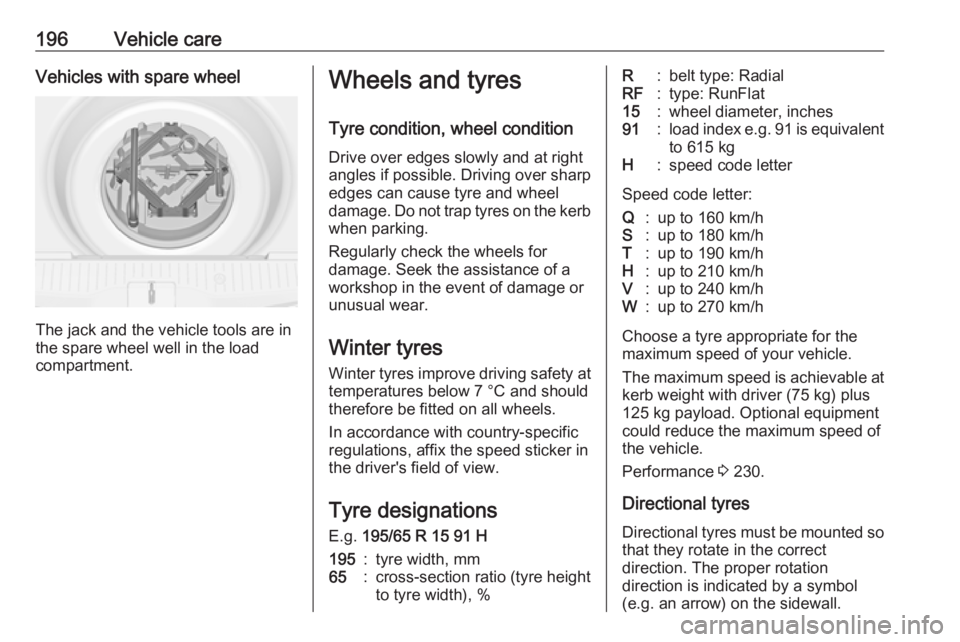
196Vehicle careVehicles with spare wheel
The jack and the vehicle tools are in
the spare wheel well in the load
compartment.
Wheels and tyres
Tyre condition, wheel condition Drive over edges slowly and at right
angles if possible. Driving over sharp
edges can cause tyre and wheel
damage. Do not trap tyres on the kerb when parking.
Regularly check the wheels for
damage. Seek the assistance of a
workshop in the event of damage or
unusual wear.
Winter tyres
Winter tyres improve driving safety at temperatures below 7 °C and should
therefore be fitted on all wheels.
In accordance with country-specific
regulations, affix the speed sticker in
the driver's field of view.
Tyre designations
E.g. 195/65 R 15 91 H195:tyre width, mm65:cross-section ratio (tyre height
to tyre width), %R:belt type: RadialRF:type: RunFlat15:wheel diameter, inches91:load index e.g. 91 is equivalent
to 615 kgH:speed code letter
Speed code letter:
Q:up to 160 km/hS:up to 180 km/hT:up to 190 km/hH:up to 210 km/hV:up to 240 km/hW:up to 270 km/h
Choose a tyre appropriate for the
maximum speed of your vehicle.
The maximum speed is achievable at kerb weight with driver (75 kg) plus125 kg payload. Optional equipment
could reduce the maximum speed of
the vehicle.
Performance 3 230.
Directional tyres
Directional tyres must be mounted so that they rotate in the correct
direction. The proper rotation
direction is indicated by a symbol (e.g. an arrow) on the sidewall.